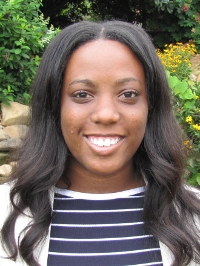2017 SRE Program Participant Profiles: Quiyana Murphy
 |
Hometown: Louisville, KY |
What is the purpose of your research?
Our project is specifically interested in describing the spread of an orthohantaviral infection between cells within an individual (i.e. "within host"). Orthohantavirus is a virus harbored by mice, shrews, moles and bats. Only when the virus accidentally spills over to humans do they cause disease. To date, there is no cure for orthohantaviruses and given the lethality of an orthohantaviral infection, it is important to study the within host interactions between orthohantavirus and the endothelial cells of a human lung. While many other mathematical models for orthohantavirus focus on the rodent to host or rodent-to-rodent transmission, there is little to no research conducted on the replication of orthohantavirus at the cellular level, making our project unique and new in nature.
![]()
Participating in this program is an excellent avenue to strengthen your academic knowledge and develop new skills while being surrounded by knowledgeable and like-minded researchers.
![]()
– Quiyana Murphy, SRE participant
What does the research ultimately accomplish?
Using a within-host mathematical model for orthohantavirus, together with experimental data, we will be able to estimate important biological parameters such as the rate at which infected cell and virus particle dies, daily viral production, and the number of secondary infections that arise from one infect cell within a population of susceptible cells. Modeling how viruses control infection in their natural host and those in which they caused disease has the potential to estimate the efficacy of different therapeutics, the strength of the immune responses, and make predictions of disease outcome, therefore guiding human intervention. This is our main goal in modeling the within host dynamics of orthohantavirus.
Describe a typical day on the job.
My day typically begins when I arrive at NIMBioS around 9 AM. I meet up with the rest of my group to discuss what the goals are for the day before jumping right to work. No day is the same. Some days consist of reading papers, discussing theory, writing computer codes, making conclusions about our findings, and discussing new information that can fit into our model. Two to three times a week, we have a meeting with our mentors to discuss our progress, ask questions, set new goals, and learn about mathematical or biological topics related to our research project.
What were your favorite parts of the SRE program?
I thoroughly enjoyed all aspects of our research project—from literature review, developing a model, analyzing the dynamics of our system, to writing computer codes. The skills I've learned at this 2017 SRE are invaluable and will be of assistance as I move forward in my academic and research career.
In addition, one of my favorite parts of the SRE program is getting to know and work with participants within our cohort. Each of us are the product of different backgrounds and walks of life, but all initially connected due to our interest in research at the interface of mathematics and biology.
The faculty and staff associated with NIMBioS are excellent mentors. The mentors are experts in their field with a wealth of knowledge that they are always willing to share with us.
What advice would you give someone who's interested in participating in the program?
I would encourage everyone who is interested in the program to apply, regardless of your level of experience with research. Participating in this program is an excellent avenue to strengthen your academic knowledge and develop new skills while being surrounded by knowledgeable and like-minded researchers. In addition, this program can serve as a great tool to refine your potential research interest.
Where do you see yourself in 10 years?
Career and research areas are almost endless when it comes to the field of mathematics. While this is true, I've always searched for an area of mathematics that can be applied to the everyday life of humans in a way that could confront several scientific and societal problems we are currently facing or may face in the future. It is with this desire to research scientific and societal problems that in ten years I anticipate to earn a PhD in mathematics, focusing in applied mathematical biology research and working on or completing a postdoc. Eventually, I would like to pursue a career in academia. I believe that I can attribute a lot of my development in mathematics and the field of mathematical biology research to professors who are accomplished and willing to provide encouragement, mentorship, and assistance when needed. In the future, it is my hope to provide this same mentorship to math enthusiasts, as well as students new to mathematics.
Related Links
Main SRE page
2017 Summer Program
NIMBioS
1122 Volunteer Blvd., Suite 106
University of Tennessee
Knoxville,
TN 37996-3410
PH: (865) 974-9334
FAX: (865) 974-9461
Contact NIMBioS


